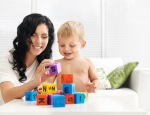 Wee Heart Music recently hosted a workshop for area Music Together teachers titled, “Music and Play…A Fresh Look.” As I was sitting in the workshop, I thought about how this information and research has shaped my thinking as a parent and a teacher over the years—I first heard this topic presented in 2012. I have decided to present some of these ideas to you in a two-part blog over the course of this winter session. I hope this information gives you a fresh perspective on play, too!
Wee Heart Music recently hosted a workshop for area Music Together teachers titled, “Music and Play…A Fresh Look.” As I was sitting in the workshop, I thought about how this information and research has shaped my thinking as a parent and a teacher over the years—I first heard this topic presented in 2012. I have decided to present some of these ideas to you in a two-part blog over the course of this winter session. I hope this information gives you a fresh perspective on play, too!
Sometimes as a busy mom, I forget to play. I have to consciously stop working and make time to play with my children. I fail at it sometimes, too. But having been a parent now for almost 12 years, and a Music Together teacher for 6, I have seen the benefits of play (and musical play) in my own and many other children. Why take time to play? Why is musical play important? Read on, and you’ll see how your musical play will pay off!
Play is fun! But it also is essential to a child’s development and learning. Play is often suggested to be a child’s “work.” Expert theorists on play include Jean Piaget, Erik Erikson and Lev Vygotsky. They all agree that the child uses play for self-teaching: the child PLAYS through situations very much like an adult THINKS through a situation. Play is the primary method young children use to learn and grow physically, emotionally, cognitively, socially and morally.
Amazingly, science has confirmed what musicians and music teachers have known for hundreds of years—that music and play are part of the recipe for creativity. Dr. Karl Paulnack spoke recently about the effect of music on the brain’s neuroplasticity, simply defined as the brain’s ability to reorganize itself by forming new neural connections throughout life. It goes without saying that neuroplasticity is a good thing—and we all want our brains to be “flexible” and developing.
He said there are four elements that have the most impact on neuroplasticity: MUSIC, PLAY, PHYSICAL ACTIVITY and NUMINOUS EXPERIENCES. To quote him directly, “Numinous experiences are those in which our sense of self is absorbed into something bigger than we are.”
Can I just pause to say—WOW! Yay for Music Together!! We use music, we play, we march and jump around, and we foster a classroom community! If you don’t take classes for your child, you may want to simply take them for yourself!
Dr. Paulnack goes on, “…music, exercise, play and being part of something greater than yourself—that’s the recipe for creative brains.”
Creative people know how to problem solve. They can think “outside the box” and are flexible thinkers. This alone may be reason enough to invest in a music class or music lessons for your older child.
Take some time over the course of the next week to PLAY with your child. Use MUSIC in your play, and you’ll double the impact on their developing brain (as well as your own!) One way to do this is simply by playing your new Bells music and repeating activities from class. Or, join a class by registering for one that still has availability!
As parents, we do lots of things for our children. We feed them, clothe them, care for them. Please don’t forget to play musically with your children too!
“We don’t stop playing because we grow old…we grow old because we stop playing.”—George Bernard Shaw
Fabulous blog post! Best wishes for a great 2015!
Patricia Pontón Azar
Center Development Representative
Music Together LLC
Princeton NJ USA
800-728-2692 x379
pazar@musictogether.com
http://www.musictogether.com
Pingback: Play Today, Part 2 of 2: Play Your Child’s Way | Rhythm and Rhymes